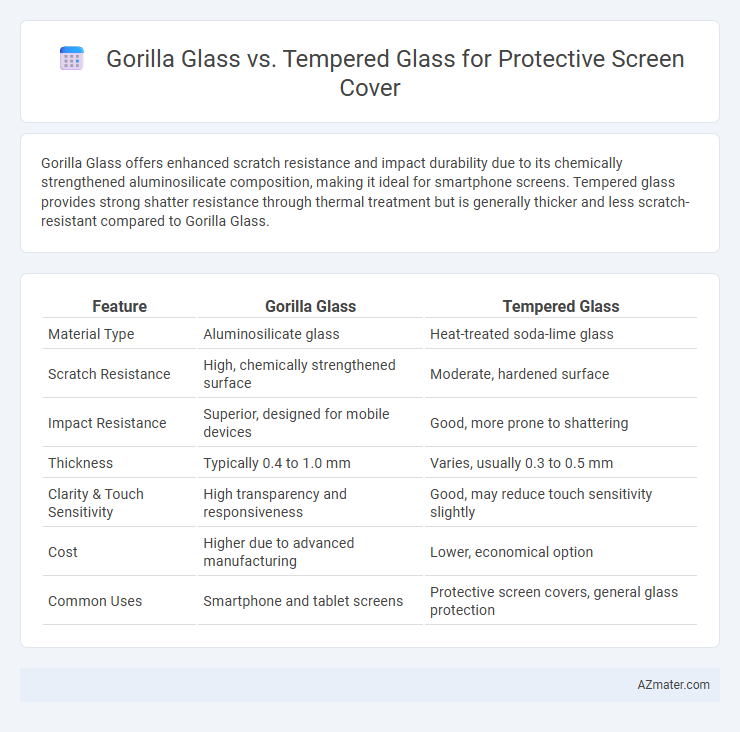Gorilla Glass offers enhanced scratch resistance and impact durability due to its chemically strengthened aluminosilicate composition, making it ideal for smartphone screens. Tempered glass provides strong shatter resistance through thermal treatment but is generally thicker and less scratch-resistant compared to Gorilla Glass.
Table of Comparison
| Feature | Gorilla Glass | Tempered Glass |
|---|---|---|
| Material Type | Aluminosilicate glass | Heat-treated soda-lime glass |
| Scratch Resistance | High, chemically strengthened surface | Moderate, hardened surface |
| Impact Resistance | Superior, designed for mobile devices | Good, more prone to shattering |
| Thickness | Typically 0.4 to 1.0 mm | Varies, usually 0.3 to 0.5 mm |
| Clarity & Touch Sensitivity | High transparency and responsiveness | Good, may reduce touch sensitivity slightly |
| Cost | Higher due to advanced manufacturing | Lower, economical option |
| Common Uses | Smartphone and tablet screens | Protective screen covers, general glass protection |
Introduction: Gorilla Glass vs Tempered Glass
Gorilla Glass, a chemically strengthened aluminosilicate glass developed by Corning, offers superior scratch resistance and impact durability compared to traditional tempered glass. Tempered glass, created through thermal or chemical treatment to enhance strength, provides effective shatter resistance but is generally thicker and less transparent than Gorilla Glass. Choosing between the two involves balancing factors such as weight, clarity, scratch resistance, and price for optimal protective screen coverage.
What is Gorilla Glass?
Gorilla Glass is a chemically strengthened glass designed by Corning, known for its exceptional durability and scratch resistance, commonly used in smartphones and tablets. It undergoes an ion-exchange process that increases surface compression, making it more resistant to cracks and impacts compared to traditional tempered glass. While tempered glass is heat-treated for toughness, Gorilla Glass offers a thinner, lighter alternative with superior optical clarity and touch sensitivity.
What is Tempered Glass?
Tempered glass is a type of safety glass processed by controlled thermal or chemical treatments to increase its strength compared to normal glass. It is designed to shatter into small, blunt pieces rather than sharp shards, reducing the risk of injury when broken. Frequently used in smartphone screen protectors, tempered glass offers durable resistance to scratches and impacts, providing effective protection against everyday damage.
Material Composition and Manufacturing
Gorilla Glass is an alkali-aluminosilicate sheet glass manufactured through a proprietary ion-exchange process that enhances surface compression, resulting in superior scratch resistance and durability. Tempered glass undergoes thermal treatment where rapid cooling increases its tensile strength, making it more shatter-resistant but generally thicker and less flexible than Gorilla Glass. The chemically strengthened Gorilla Glass offers a thinner, lighter profile with enhanced impact resistance compared to the mechanically toughened Tempered glass used in protective screen covers.
Scratch Resistance Comparison
Gorilla Glass outperforms tempered glass in scratch resistance due to its chemically strengthened aluminosilicate composition, which provides higher surface hardness and resilience against abrasions. Tempered glass, though tougher in impact resistance, is more susceptible to surface scratches as it lacks the advanced ion-exchange treatment found in Gorilla Glass. Studies show Gorilla Glass can maintain clarity and structural integrity longer when exposed to everyday objects like keys or coins, making it a superior choice for durable protective screen covers.
Impact and Drop Protection
Gorilla Glass offers superior impact resistance due to its chemically strengthened aluminosilicate composition, making it highly effective against drops and scratches compared to standard tempered glass. Tempered glass, created by rapidly cooling heated glass to increase its strength, provides good shatter resistance but is generally more prone to cracking upon high-impact drops. For optimal drop protection, Gorilla Glass's enhanced durability significantly reduces the likelihood of screen damage under typical drop scenarios.
Thickness and Aesthetics
Gorilla Glass typically ranges from 0.4mm to 1.2mm in thickness, offering a slim and sleek profile that maintains device aesthetics with its smooth, glossy finish. Tempered glass, often thicker between 0.3mm and 0.5mm, can add noticeable bulk, slightly altering the screen's original look and feel. Gorilla Glass's advanced chemical strengthening process preserves clarity and touch sensitivity better, making it a preferred choice for premium, aesthetically-conscious screen protection.
Cost and Availability
Gorilla Glass offers superior scratch resistance and durability but comes at a higher cost and is primarily found on premium smartphones and select tablets. Tempered glass screen protectors are more affordable and widely available in various thicknesses and hardness ratings, making them a popular choice for budget-conscious consumers. The broader market presence of tempered glass allows for easier purchasing options through online retailers and local stores compared to the relatively niche Gorilla Glass.
Suitability for Different Devices
Gorilla Glass offers superior scratch resistance and enhanced durability, making it ideal for high-end smartphones and tablets that require thin, lightweight protection without compromising touch sensitivity. Tempered glass, known for its shatter-resistant properties, suits devices prone to heavy impacts like rugged phones and budget models where cost-effective, strong screen protection is a priority. Both materials provide robust protection, but Gorilla Glass excels in premium devices demanding clarity and thinness, while tempered glass is favored for affordable, heavy-duty coverage.
Which Screen Protector Should You Choose?
Gorilla Glass offers superior scratch resistance and higher impact durability compared to tempered glass, making it ideal for long-term screen protection on smartphones and tablets. Tempered glass screen protectors provide affordable, effective protection against everyday scratches and minor drops but may lack the advanced toughness and oleophobic coating found in Gorilla Glass. Choose Gorilla Glass for premium, long-lasting protection and tempered glass for budget-friendly, reliable coverage.

Infographic: Gorilla glass vs Tempered glass for Protective screen cover
 azmater.com
azmater.com